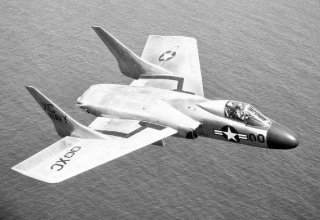Vought F7U Cutlass: The Navy Plane That Had 'Nazi' DNA
Even though the Cutlass incorporated elements from some of Nazi Germany’s most advanced airplane designs, it was one of the Navy’s most dangerous planes to fly.
Aircraft in the post-World War II era featured a number of novel designs as aerospace engineers mated newly-created jet engines with advanced airframes intended to push the limits of speed and overcome the sound barrier — a feat that would prove to be difficult to achieve. In recognition of the advanced aircraft designs Nazi Germany built and flew with some success during the waning days of the war, a number of aerospace companies — American, British, and Soviet — studied German airframes and incorporated a number of features into their own airplane designs. One of these was the United States’ Vought F7U Cutlass.
The Cutlass differed significantly from most other American airplanes, and leveraged research the German firm Arado had conducted during the Second World War. Vought designed the Cutlass for speed, and to that end, the airplane lacked a tail and featured large swept wings, both of which the airplane’s designers hoped would reduce drag at high speeds. Hopes were high for the twin-engine jet, with one 1948 article predicting that the F7U would prove not only to be the Navy’s fastest airplane but that it would eventually burst through the sound barrier as well.
The Cutlass also featured a number of elements new to the U.S. Navy, including fully steerable landing gear as well as high-pressure hydraulic flight controls and a new jet engine design. Unfortunately for the pilots who flew the Cutlass, the jet airplane’s engines were underpowered, its landing gear was not robust enough for the stresses of carrier operations, and its hydraulic system was leaky and prone to failure. It was in a word, deadly.
In one memorable accident, a Navy pilot ejected from his Cutlass, fearing an imminent crash. His jet, armed with 2.75-inch rockets, continued to fly for another half-hour after ejection, flying in the vicinity of San Diego before it lost altitude and crashed near the beach.
In another tragic accident, a Cutlass failed to attach to arrestor cables on the USS Handcock’s flight deck and barreled into the arresting net at the deck's far end. The force of the impact drove a nose gear strut into the plane’s cockpit and set off the pilot's ejection seat, throwing the pilot several hundred feet into the air and into a parked airplane, severely injuring the pilot who later died of his injuries.
So great was the number of accidents during air shows or on carrier landings, a number of Cutlass pilots simply hung up their flight gear, refusing further flight with the problematic airplane. On at least one occasion, a Navy officer ordered all Cutlasses to be removed from his carrier, out of concern for crew and pilot safety.
Vought’s F7U Cutlass would ultimately serve for a paltry 8 years, retiring in 1959. Despite the aircraft’s advanced design, perhaps its greatest distinction was as one of the Navy’s deadliest airplanes: 25% of Cutlass airframes were lost due to accidents, the highest accident rate of any swept-wing U.S. Navy airplane. Despite the Cutlass' advanced design, it just wasn't enough to be a successful Navy fighter.
Caleb Larson is a Defense Writer with The National Interest. He holds a Master of Public Policy and covers U.S. and Russian security, European defense issues, and German politics and culture.
Image: Wikimedia Commons

